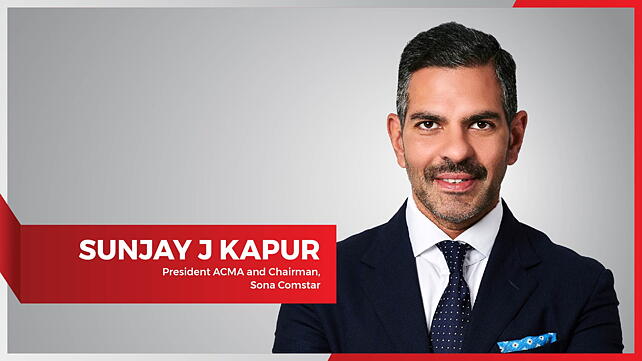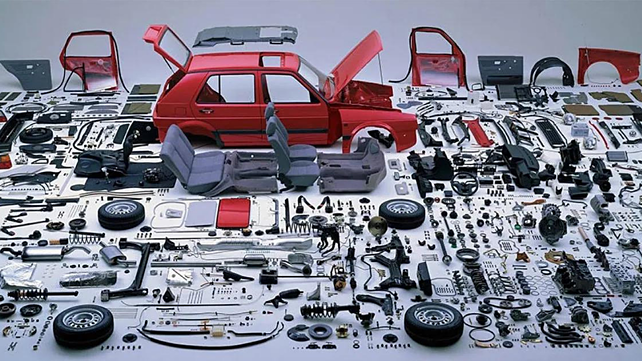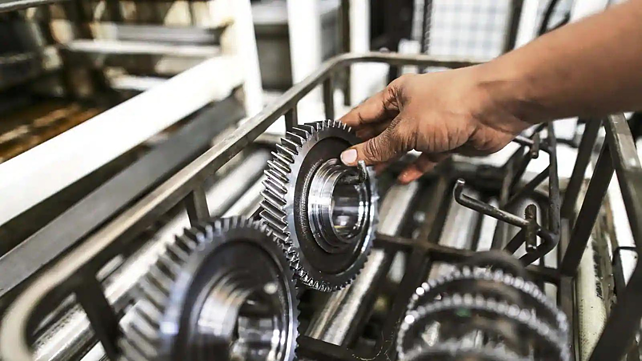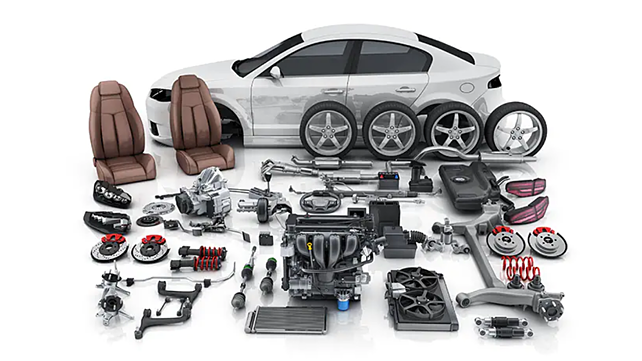
An alumnus of the prestigious Doon School and the Harvard Business School, Sunjay J Kapur is currently the Chairman of Sona Comstar. In 2009, he was appointed as the Chairman of the supervisory board of Sona BLW Precision Forging Limited. Later in 2012, he became a member of the executive committee of Automotive Component Manufacturers Association (ACMA), of which he is the current President. Kapur was also initiated as a member of the Northern Region Council of Confederation of Indian Industries (CII).
How has the Indian auto component industry fared in the last year, given the multitude of challenges it faced?
We had good growth during last year. The exports alone grew by 76% in FY22 compared to FY21. The industry reported $13 billion of exports during the financial year, domestic sales of $37 billion, and aftermarket $10 billion. So, we've seen good demand. Demand creation hasn't been a problem; however, supply is an issue.
The problem first started with the advent of COVID, which led to the global lockdown, resulting in supply chain disruptions. The issue was further exacerbated by the chip crisis due to the global lockdown.
The war has created more challenges with the supply chain and more headwinds, as 95% of the neon gas supply comes from Ukraine. Coupled with that is the impact of China and the lockdowns in China; although we haven't directly seen the impact at the moment, we foresee some impact in terms of logistics, when it comes to imports from China.
In FY15, ACMA announced its intention to reach $100 billion by FY20, which hasn’t been achieved yet. Given the current trend, when do you see accomplishing this milestone?
The fact that demand exists is a positive for us. We've got great demand. And the only challenge today we face is the supply chain, which has already sort of alluded to the fact that we have headwinds with regard to semiconductor chips. And this is not just for our industry, but we’re seeing this globally.
We will see the constraints with semiconductor chips continue through the rest of the calendar year, at least as far as we can see. Once that evens out, capacity is not so much of a problem any longer. It's now a matter of neon gas, which again if things get better from the conflict perspective, we'll be sitting in a pretty good shape. We're hoping the second half of the calendar year for things to even out.
Considering the post-pandemic situation, what kind of opportunities do you see for the automotive component industry?
The opportunities are immense; the kind of opportunities we have include connected, autonomous, electric, and shared. So while they're challenging, they're also great opportunities. Companies investing in technology see great opportunities going forward.
The EV market in India for 2W is 2%, 3W 4.7%, passenger cars 0.7% and buses 3.6%. Also, we expect the 2/3W market to convert to EV much sooner than any other market.

Even if you look globally, we see a rapid increase in electric vehicles. And most sales are happening in that space. Therefore, the opportunity to supply into the EV market is huge. The ecosystem around electric vehicles is also something that companies will have an opportunity to supply, whether it's battery technology or charging infrastructure.
There is also a great opportunity for the Indian auto component manufacturers in the connected and autonomous segment with the whole play on software, data analytics and AI.
If we look at product and process technologies, they will be very different from those in the past. This generation of businesses will define what will happen in the automotive industry in the future, whether we talk about the standard of batteries or charging stations and building out charging stations and infrastructure or the rest of the ecosystem in electrification.
This will be critical, and it's going to be a great big open space for the component industry to play.
The current geopolitical situation is putting much pressure on the industry. But are there any positive takeaways from the situation?
The positives will come when we as an industry invest more in technology to have less dependence on imports. And that's something that has been an endeavour for the industry. If we go back to 2008, when we went through the financial crisis, we were put in a situation where we had to start looking at localisation.
We were looking at localisation for a very different reason – foreign exchange fluctuation, which was very high then. And OEMs gave a pass through when it came to foreign exchange fluctuation, that it became actually expensive to import.
We've continued to look at localisation programmes. The big challenge we're facing today is in the electronic space, not just in automotive but across industries. Therefore, the focus on manufacturing in India will have to be the localisation of electronics and other components. We've learned this not just from the conflict we see in Russia and Ukraine but also from the pandemic, where we want to create less dependence.
So, when you look at businesses that can supply to export to global markets, it's not because of labour arbitrage but the advancement of technology; it's because of the investments they make in technology. If you're not going to make those investments, you will be left behind.
That's going to force us to invest in technology, which will be a competitive advantage going forward. Today's need is to invest in technology, not just by Tier-1 suppliers, but those in Tier-2 and Tier-3 as well, due to the complexity of the supply chain.

On one side, we see the industry facing challenges due to the current scenario, while on the other side, we see many of the global players turning to Indian component suppliers for their global products. How do you assess the situation?
We've got several IPOs (international purchase offices) working in India with ACMA to source components. And these IPOs are from Tier-1 suppliers as well as OEMs. It's a very active forum, working with ACMA and its member companies, and other companies in the auto components space in India to source components.
Again, it's a great opportunity for us. Any opportunity to supply into the global supply chain is ample because the numbers and the volume are there. While we're the fifth-largest market, we still have the United States, China and Europe that we can feed into.
When we look at investment in technology, we want to supply where there is scale. And the only scale that we're seeing today, even if we look at the EV space, is outside of India. So for us to invest in EV technology, we have to look for scale, and therefore supplying to global markets is the way the component companies are looking at.
Is this sufficient to make the Indian auto component industry future-ready?
We've got many centres of excellence that we started where members have access. We also have alliances with IIT Delhi in the Sonipat campus and IIT Mumbai for electrification and technology.
We feel that the academia and industry connection is vital because we will be able to leverage academia. So bringing these two together will improve research and development and lead to the creation of technology-based solutions for the end customer. This is where we're helping our member companies.
In terms of the chip crisis, although many are struggling with production, few of the OEMs are claiming to have gotten around the problem. What is your take on this?
I think what's happening is a balancing act. They are balancing out which models to build and when because of constraints in chip supply. For example, if an OEM has got 100 chips while it actually needs 300, the company will put the 100 on the model that will be sold more than a model that may not have very high growth or high sales.
I think OEMs will look at maybe consolidating parts, but I don't feel that we can run away from this problem where we need chips. But, again, this is a cyclical problem; it's not a structural problem. It's a cycle, and we're going to come out of it. We're a very resilient industry.
The Indian auto component industry wanted to become a competitive cost manufacturing base from a low-cost manufacturing base. Where are we now?
I think we are a great manufacturing base. We are well-positioned to become a manufacturing hub for the world in terms of cost, processes, systems, quality, delivery and most importantly, technology. We are in the right place at the right time, and we are headed in the right direction.
I come back to the fact that the Government pushing us to invest in future technologies gives us that edge to become a hub for manufacturing for the world. This is a great time to be in the automotive industry. If we look at FAME II, ACC for battery, and PLI for auto companies, we are looking at INR 54,000 crore. The outlay is huge, and the Government is willing to put more money behind it if we can reach our goals and meet our targets.
And if we look at just the auto component industry, we have 75 companies approved for the PLI scheme, and these companies with a minimum investment of INR 250 crore over five years equals INR 18,600 crore.
We will see much investment come into the auto component industry. With that, we will also see job creation and investment in future technologies. We are sitting in a great position to become a manufacturing hub for the world.

Of course, it is a great time for the industry and to be in the industry. But are there any pain points to be addressed at this point?
I think the private sector's role is to invest in technology. I don't think we now need help from the Government; instead, we need to put our money where our mouth is and invest in technology as the private sector.
I think from a Government perspective, there needs to be some amount of alignment with the private sector when it comes to charging infrastructure, especially on electric vehicles, when it comes to standardisation of batteries or even when it comes to investments for components for electric vehicles; we need to leverage that opportunity.
Besides, the financing of EVs is very expensive because I think finance companies today are not convinced that the new age EV companies are reliable enough for them to finance. So we need to look at how we can improve the financing for electric vehicles going forward, and that's the sort of help and assistance we would like from the Government.
What are your short-term and long-term plans?
Our short-term plan is to leverage technology and market space for disruption and bring more start-ups into our ecosystem. We've started a programme where we are encouraging newer kinds of memberships. We already have 47 alliance members in logistics, EV components, battery space, and others.
We want to increase that number and don't want to limit ourselves to the traditional automotive component manufacturers. We need to look at mobility as a business. We are now no longer an automotive industry, but we're a mobility industry, and we can supply anything that's mobile.
Our endeavour is to bring a new set of members on board in the mobility space. We are working closely with PwC and start-ups to create a culture of start-ups and maybe an incubation centre for them. Alongside we also have the IIT alliances, and the academia-industry connect.
In the long-term, we want to leverage this growth. Today, we are sitting at close to 800 members, and I hope we can take this 8,000 so that we can become a stronger body and help assist our members in taking their businesses to the next level in terms of technology and growth.